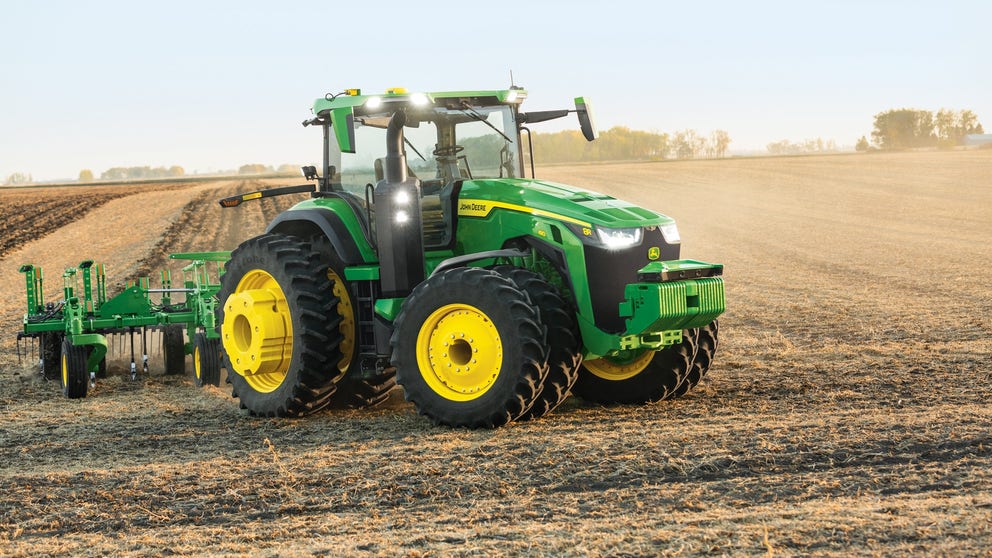Less land, labor fuel need for John Deere's self-driving tractor
The days of spending 12–18 hours in a tractor to grow food for consumers might be changing with the swipe of the finger
Less land, labor fuel need for John Deere's self-driving tractor
The world’s largest farm equipment manufacturer is undergoing a large-scale production of their self-driving John Deere 8R tractor that promises the only thing farmers need to do is transport the machine to a field and configure it for autonomous operation.
WATERLOO, Iowa – One look at a farmer's callused and cracked hands after a long dedicated day in the fields, you can begin to understand just how tough and dirty the business really is.
But the days of spending 12–18 hours in a tractor to grow food for consumers might be changing with the swipe of the finger from an app.
The world’s largest farm equipment manufacturer is undergoing a large-scale production of their self-driving John Deere 8R tractor that promises the only thing farmers need to do is transport the machine to a field and configure it for autonomous operation.
Deere said their autonomous tractor expected to roll off their factory assembly line in Waterloo, Iowa, later this year serves a specific purpose: feeding the world.
"With people moving from rural to urban areas, there is an ever-increasing gap between the labor that's needed and the labor that's available," Deere’s Chief Technology Officer Jahmy Hindman said during a news conference at CES 2022.
"Farmers need technology to help them do more with less minimizing their inputs, maximizing their outputs so that we can all put food on the table. And that leads us to today."
With labor shortages and higher input costs, technology advancements allow farmers to keep providing the food, fuel and fiber they depend on, said Rich Felts, a Montgomery County, Kansas farmer and president of Kansas Farm Bureau.
"Precision ag technology has proven to improve efficiencies on the farm while providing safe, economical solutions," Felts said.
One of the greatest challenges that farmers face is growing enough food to feed the world while using the same amount of land they have today and work through changing weather conditions, variations in soil quality and the presence of weeds and pests.
The global population is expected to grow from about 8 billion to nearly 10 billion people by 2050, it will also increase the global food demand by 50%, according to industry experts.
In 1918, Deere launched its first two tractors, the Waterloo Boy and the John Deere tractor.
"This marked the beginning of the end for the horse in front of his plow. Now, if you fast-forward about a 100 years later, you'll find some of the most advanced robotic machines are being used on the farm to feed the world," Deere’s Chief Technology Officer Jahmy Hindman said during a news conference at CES 2022.
With the introduction of Deere's autonomous tractor, the farmer can leave the field to focus on other tasks, monitoring the machine's status from their mobile device while it is working.
It can prepare over 325 acres of soil in 24 hours — that’s bigger than the land area of the National Mall in Washington, D.C.
The tractor has six pairs of stereo cameras, which enables 360-degree obstacle detection and the calculation of distance. The images are then classified by each pixel in approximately 100 milliseconds to determine if the machine continues to move or stop if an obstacle is detected.
In addition, the tractor is also continuously checking its position relative to a geofence, ensuring it is operating where it is supposed to, and is within less than an inch of accuracy, the company said.
Over the course of one growing season, a Deere farmer utilizing their technology can also avoid CO2 emissions the equivalent of over 992,000 passenger car miles driven per year.
However, while the Kansas Farm Bureau's member-driven policy supports these advancements in agriculture, Felts said the lack of adequate, reliable rural broadband is a limiting factor.
"We also want to be cognizant of the day-to-day efficacy of the technology and make sure it meets the needs of farmers and enhances farm safety," Felts said.
Deere plans to operate autonomous tractors on 10 to 50 farms by this fall before significantly increasing the number in following years, according to reports.
And while the company has not said how much their autonomous tractors will set farmers back, the latest technology will reportedly be added onto machines that sell for about $500,000.






